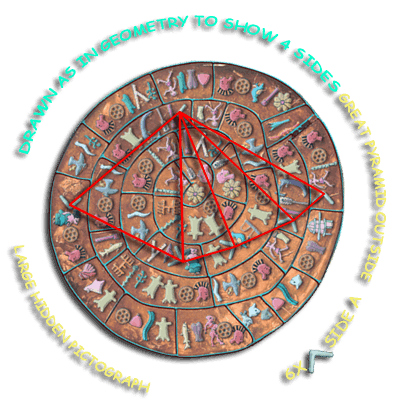
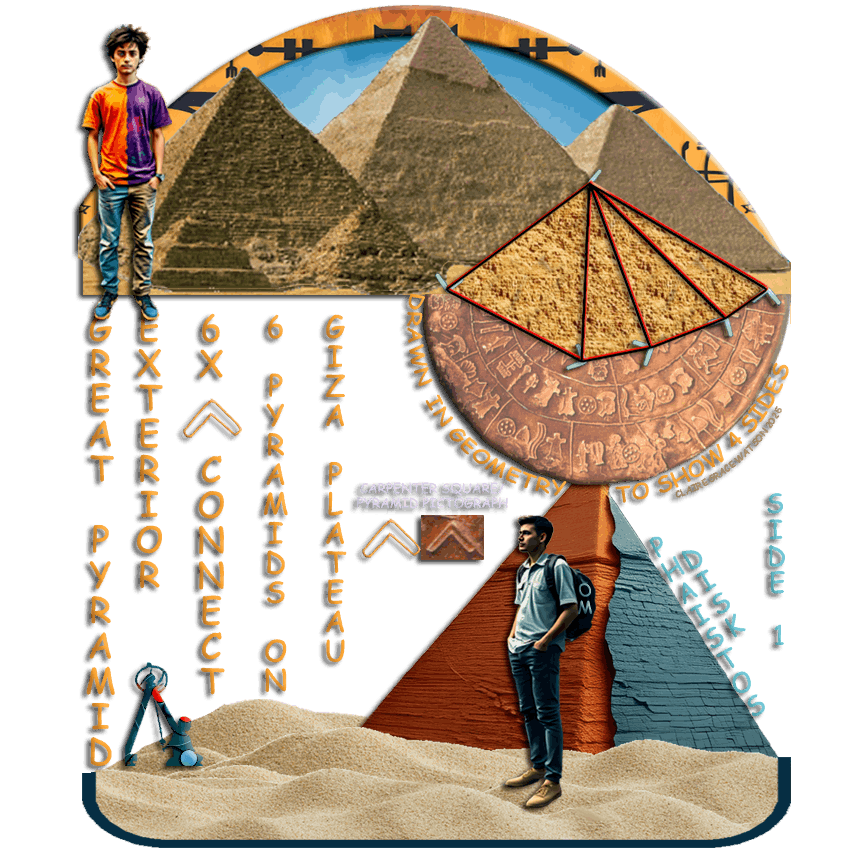
"And in that day the country that was more pious than all countries will become impious. No longer will it be full of temples, but it will be full of tombs. Neither will it be full of gods but it will be full of corpses. Egypt! Egypt will become like the fables." (Asclepius, the Nag Hammadi Papyri)
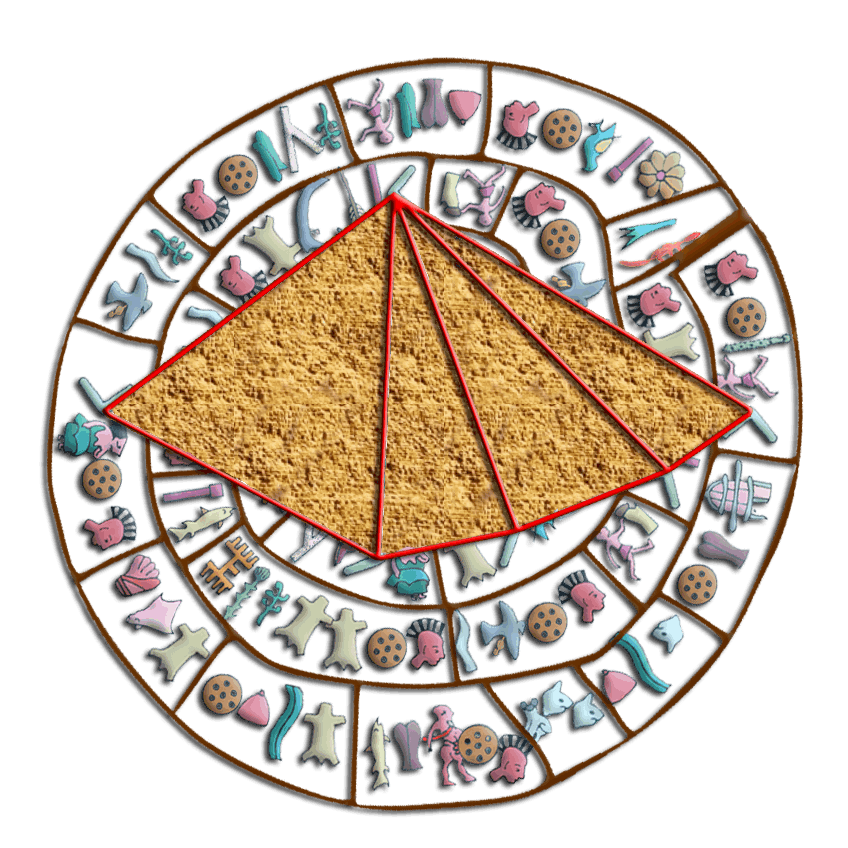
They sailed
Not everyone walked; some were carried in palanquins.
Phaistos Disk Hidden Pictograph - Great Pyramid, Exterior
Today the chorus is singing, "This is the dawning of the Age of Aquarius," but when the disk was created it was the dawning of the Age of Aries from which came the Greek legend of Jason and the Argonauts. It was preceded by the Age of Taurus, supposed to have
been between 4320-2160 BCE (4525-1875, dates vary). An Age, lasting about 2,000 years or so, receives its name from the sign through which the
sun passes year after year as it crosses the equator at the Spring equinox (equal night), when night and day are equal in length all over the world,
each lasting 12 hours on this day.
During the Mediterranean Bronze Age, the Aegean people were making a transition from the Age of Taurus and old religion of
bull-worship to the Age of Aries. This was no less a transition from a primitive, idolatrous religion, tied to millenia of Dualism as basic to religious thought, to the beginnings of a scientific-philosophic
world-view and Emantionism and the "One" source of life. The Minoan ascendency over the bull is dramatized perhaps by the bull sports at the center of their festivities.
When the shift comes and the ages change from Taurus to Aries, the worship of the bull is not transferred to the worship of the ram, but instead the worship becomes
a quest for god/dess, who is conceived of in such a way as to be sought after. With the Minoans comes the idea of the Seeker and, for them, as well as for the evolution of consciousness, the Seeker of knowledge is finally the same thing as the Seeker of God/dess.
Perhaps this seeking after the goddess in the sky motivated the development of astronomy in Minoan Crete, with the idea that if we
invent telescopes and binoculars and astronomical measuring devices, we can seek the goddess through seeing her, getting closer to her and
knowing her well. Perhaps this astronomical questing for the divine led to our recognition of the universal powers of time and infinity and
the higher powers of destiny, and to conclusions about such things we might have drawn from stargazing. For the Aegean people, these eternal powers
seemed to emanate from the stars, and it stands to reason that the biggest star, Sirius, must be the most powerful. Therefore, from this star,
an eternal and perfect goddess high in the sky, flow all the gifts in heaven and earth.
Long abandoned as a tomb, or perhaps never intended as such, the pyramid might have been a source of income for the pharaohs. By 700 BCE, the pyramid was a well known tourist attraction complete with pyramid guides. The Phaistos Disk seems to roll that date back to at least to 1600 BCE, the date the Disk was created and the same date given for the first construction of the 63 tombs in the Valley of the Kings for the pharaohs and nobles. Perhaps lucrative income from pyramid tourism financed part of the construction of the tombs and the vast treasures found therein.
How did the Minoans have reliable, safe access to the Great Pyramid? This Egyptian mural portrays Minoans bringing gifts of jewelry, metal, vases, and other treasures, probably to the pharaoh, ca. 1600 BCE. Was the Minoan wealth so abundant that it overflowed their own civilization and greatly enriched the Egyptian world? Even so, they would still need some
protection to travel openly into the remote vastness of Egypt, 2,600 years before Cairo was even built.
Phaistos Disk pictographs might relate this ancient Minoan myth. This is the story of how the Curetes saved the god Zeus and became his chosen people. Rhea (left with baby on her lap) entrusted the care of her son to five immortal Curetes, also called Dactyls, meaning fingers (the glove). There are exactly five Dactyl pictographs on the Phaistos Disk. Rhea hid the baby Zeus in a cave on Crete and then invented the Dance of the Labyrinth (Kronou Teknophagia or Crane Dance) to amuse Zeus and to protect him. She surrounded him with warriors banging their shields (the warriors and disk/shield pictograph). Zeus eventually overthrew his hungry father Kronos. Then, Rhea taught the Crane Dance to the Curetes (Cretans), who preserved the tradition and re-enacted the drama in the dance. In this Greek dance, in modern times as in ancient times, the dancers joined hands and one row danced in one direction while the inside row danced in another direction. This might be visualized by this animation of the disk when the warrior signs are connected by lines and the disk is set in motion.
This view of the goddess seems to support the idea that Minoans were at the pyramid to view the goddess, the big star Sirius (right), conceived to be the Goddess Isis-Sothis. My excavation of two pyramids on this disk, one an exterior view and the other an interior view, makes me wonder if there is another pyramid to find, perhaps a view from the top, a prime location to view the goddess. It also encourages me to conclude that the Minoan astronomers and tourists had personal knowledge of the interior of the pyramid, where they went down into the subterranean chamber. Wonder what they did down there, goddess worship?
Is this next curiousity just coincidence? The Great Pyramid has an entrance leading to a subterranean chamber. The doorless shed in
which the disk was found in Phaistos was entered through a trap door above. Is is possible that, perhaps at one time, another such disk was left in the subterranean chamber of the Great Pyramid but since has been removed and lost? Or perhaps it is still hidden there.
Cheops has long been claimed as one of the most famous archaeoastronomical sites, and here we see a record of its use. This familiarity with the Great Pyramid might also indicate that the Minoan astronomers knew the pharaoh, which could have been any one of them from Khufu (Cheops) to Merneferre Ai. According to the legend associated with the pyramid at Hawara in Egypt, the Minoan inventor Daedalus found it so a-maze-ing that he
designed his famous Maze of Daedalus according to this pyramid design.
The Minoans were renown commercial and residential architects and builders. Did they help build the Great Pyramid? If they did not
help in the building of the pyramid, Daedalus or whoever created the Phaistos Disk certainly knew the location of the door that leads to the subterranean level. Inside Cheops at the bottom is an entrance to the underground level where a shaft extends deep below the pyramid. On the Phaistos Disk is an
image that shows the location of this entrance to the lower shaft level.
No warriors are visible in these ferries (below) so perhaps they were encamped in Egypt. This seems possible because archaeologists recently discovered Minoan settlements in Egypt. Could it be the warriors were encamped there and available for "tourists" such as these?
Minoan cruise ferries today, Anek and Minoan Lines, in Heraklion, Crete, are the result of a 4,000-year evolution of cruise ferries that began in the Bronze Age.
Minoan Crete is widely credited with identifying and naming our constellations. Did Minoan stargazers with primitive telescopes
The astronomers likely climbed Cheops to view the night sky from the top of the world's tallest building, which would not have
helped nearly as much as having a telescope, but it does seem to be a good idea to go up there to get closer to the stars. Is that why it was built?
It is tempting, of course, to read these pictographs like a language, but given the four major images that appear on crowded side 1
of the disk -- the perimeter, the two pyramids, and the big star -- and the others, we have to allow that the pictographs were placed in their respective places in
order to produce these hidden images/pictographs and were never a language. Linguists will eventually have to concede this, and even Sir Arthur Evans,
early on, identified the Phaistos Disk signs as pictographs rather than script.
A pictograph that made perfect sense to the Minoans and
was immediately recognizable by them might make no sense to us at all. Furthermore, while the number of constellations, 48, remains the same to this day, the Minoans
may have drawn the constellations differently or the constellations may have evolved into something quite different over time.
(Canis Major, right, revealed when the five
But no matter
how much hazardous historical television we engage upon, will we ever understand how a civilization can perceive something special about a dog
scratching its fleas? You have to go to Crete and observe their relationship with dogs to have a clue, and even then it's baffling; so many dogs roaming freely in downtown Heraklion.
The Phaistos Disk pictograph of a dog scratching fleas is compared with Minoan cylinder seals of dogs scratching fleas. Is there some special meaning about which leg the dogs use to scratch? The Phaistos Disk pictograph shows a dog scratching with its left leg but all the cylinder seals show the dog scratching with its right leg. When you walk out the front door of Heraklion airport the first thing you notice are the stray dogs lying around by the front door.
Why do they encourage it? Perhaps Cretans today intuitively perceive the dog as supplying the "living continuity" to their ancient past and their veneration of the star Sirius in Canis Major, the "Great Dog" constellation, and that explains their accommodation of so many stray dogs in downtown Heraklion.
The Minoans may have included the symbols for the constellations in much of their art and not just on the Phaistos Disk. Is this just an impossibly huge dog on a bead-seal (above, left) or could it represent the "Great Dog constellation," Canis Major and the "dog star" Sirius?
"The fact of orientation links up with the fact that there early arose a close association between various gods and
the sun and various fixed stars. Whatever mass of people outside were thinking, the priests of the temples were beginning to link the movements of those
heavenly bodies with the power in the shrine. They were thinking about the gods they served and thinking new meanings into them. They were
brooding upon the mystery of the stars. It was very natural for them to suppose that these shining bodies, so irregularly distributed and
circling so solemnly and silently, must be charged with portents to mankind. This clear evidence of astronomical inquiry and of a development
of astronomical ideas is the most obvious, but only the most obvious evidence of the very considerable intellectual activities that went on
within the temple precincts in ancient times. Outside the temples the world was still a world of blankly illiterate and unspeculative human
beings, living from day to day entirely for themselves." (H.G. Wells, The Outline of History)
This Great Pyramid geometry indicates knowledge of how it was built, all pictographs revealed by connecting matching pictographs.
Phaistos Disk Hidden Patterns - (1) Great Pyramid, Outside (2) Great Pyramid, Inside (3) Apex, base, and two sides (4) Right Triangle (5) Diameter
Geometry is like a spiritual component of the physical world because it exists in potentia and is "invoked" like spirit when we begin connecting points with lines. Knowing these religious sciences as well as s/he did, the creator of the Phaistos Disk (Daedalus?) might have conceived of this clever way to invoke images by connecting pictographs (dots) with lines, that was both astounding to those who saw it and instructive as well. Most likely, the creator of the disk was highly educated in the study of containment of geometrical arrangements, their relationship to numbers (below), and the development of "method of exhaustion."
"Method of exhaustion shows how to 'exhaust' the area of a circle by means of an inscribed polygon; if we successively
double the number of sides in the polygon, we will eventually reduce the difference between the area of the polygon (known) and the area of the
circle (unknown) to the point where it is smaller than any magnitude we choose. This method made it possible to calculate the area of a circle to
any desired degree of accuracy; with a little further development, it could be used to calculate the area within (or under) other curves as well
and to calculate the area bounded by certain spirals, and the surface area and volume of a sphere."
(David C. Lindberg, The Beginnings of Western Science, pp.88, 89)
The method of exhaustion was probably borrowed by Euclid from his predecessor Eudoxus, (Ibid)
(400-355 BCE), a Greek astronomer and mathematician credited with this inventive method of calculating proportion. The Phaistos Disk,
containing the geometry of a pentagram inside a heptagon (the big star Sirius), seems to show exhaustion in use 1200
years before Eudoxus.
The number philosophy, shown in the table below, makes of a circle, in the mystical sense and in terms of mysticism of a
much later period, an alchemical vessel, a Mixing Bowl, in which can be seen and analyzed the alchemical stages in the action of the Absolute
in differentiating Self into a phenomenal universe through geometry. Each alchemical stage is introduced with 1-13 of the 13 precepts of the
Emerald Table of Hermes Trismegistus, a legendary alchemical enigma and text puzzle from a much later period in history. Various cultures
claim to have discovered the Emerald Table-Tabula Smaragdina. In one account of discovery, Alexander the Great found the table in the
tomb of Hermes (Thoth). In another account, Sarah the wife of the biblical Abraham, found the entombed Hermes holding in his hands his table.
Alternately, the precepts may have been written in Syriac.
"These precepts of Hermes were cherished with a kind of religious fervour by the adepts (of alchemy), who looked
upon them as summarising in a concealed form the fundamental secrets of alchemy and of the Philosopher's Stone."
(John Read, F.R.S., From Alchemy to Chemistry)
In this geometry theology, ultimate reality is numerical, number is the key to the universe, and triangles are the
fundamental building blocks of the cosmos; therefore, geometry is sacred. Included in the table are the precepts of Hermes, assigned to the geometry well over 2,000 years after the Phaistos Disk created, but this recounts the ancient tradition of ushering this enigmatical knowledge through the ages so that it does not get lost nor is understood by any other than initiates.
Geometry seems to have originated with the study of the vertex-vortex and involved,
pre-eminently, the triangle and its uses in describing the properties of a circle and the geometry of the sphere for use in astronomy. Traditionally, we
attribute this knowledge to the ancient Egyptians and credit them with the early work in geometry that involves this science of containment
of geometrical arrangements. But to attribute all this knowledge to the Egyptians and to say that the Minoans had no knowledge of this, or
were not major contributors to this early geometry, is to deny their brilliance and creative genius, which no right-minded person would do
that took the time to look at the rest of their mighty civilization. The Phaistos Disk proves the Minoan's accomplishments in this science.
"I've loved reading your research, it's fascinating. You have a great mind for pictographs!" (Heidi Bosley)
![]() across the Aegean Sea
across the Aegean Sea ![]() to Egypt, continued down the Nile River then walked
to Egypt, continued down the Nile River then walked 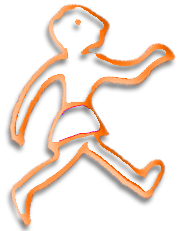 to the Great Pyramid
to the Great Pyramid ![]()
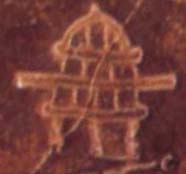

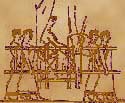
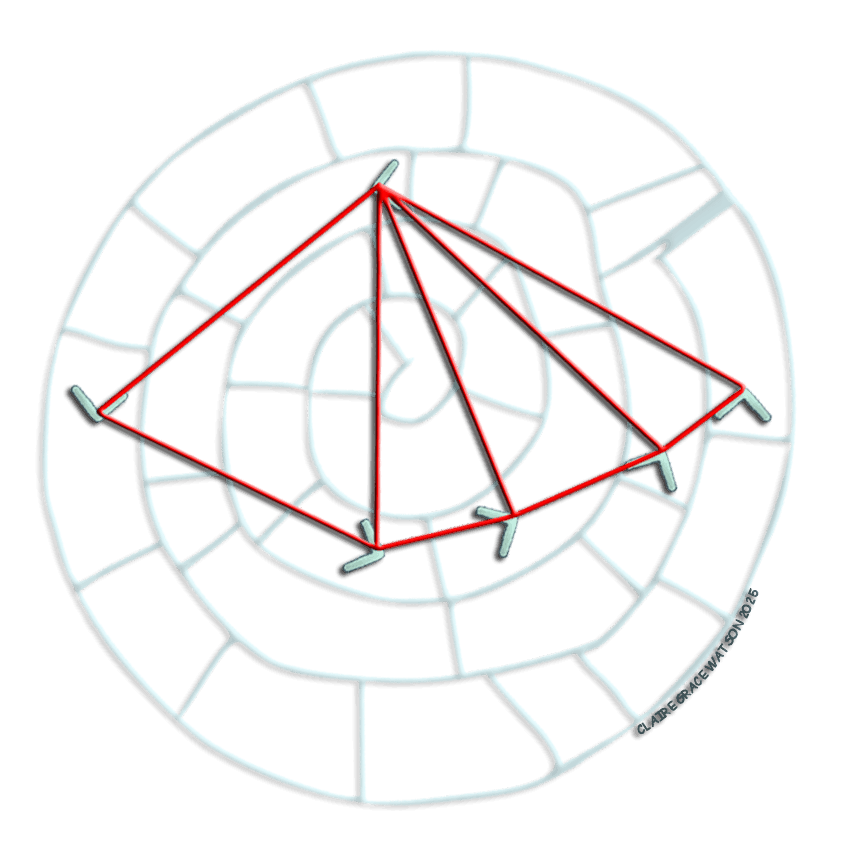
 Read the Phaistos Disk
Read the Phaistos Disk
"Carpenter's Squares (geometry)
built the Great Pyramid."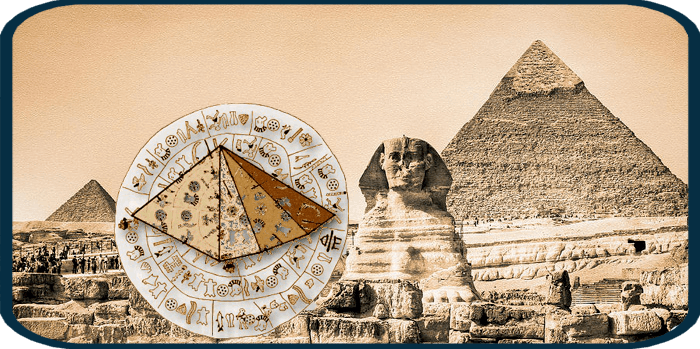
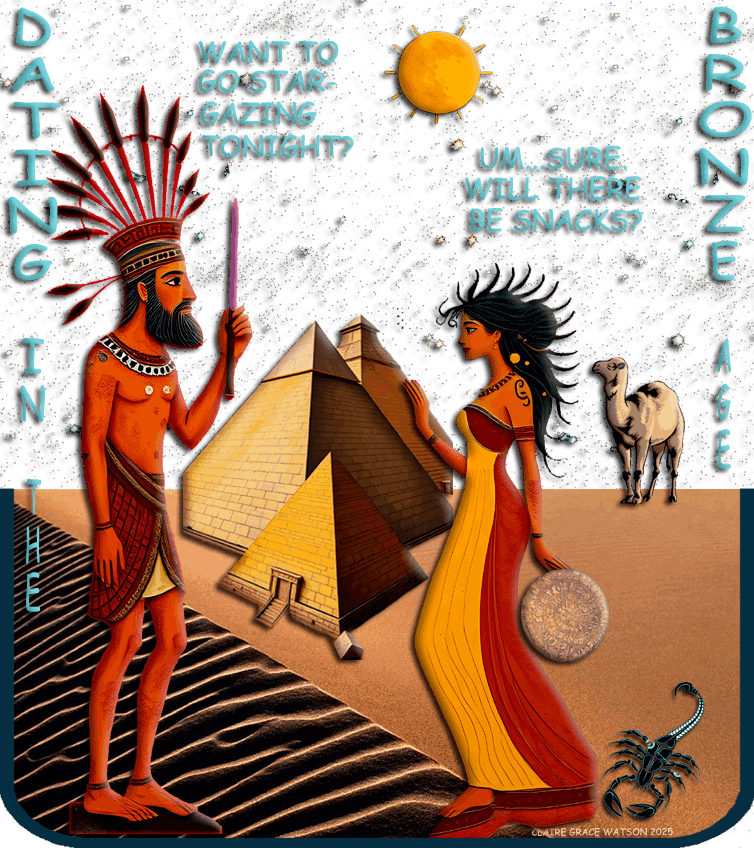
![]()
 Overlighting this early human fascination with number and geometry were the stars, and perhaps their participation was not passive at all. There is the possibility of human brain embeddedness of starlight (left), which could account for the enlightenment, development, and expansion of human consciousness. We do not have to concede this intimate relationship with the stars to continue this theory of Minoan astronomy, but we do concede the contribution the stars make in the form of the astronomical ages.
Overlighting this early human fascination with number and geometry were the stars, and perhaps their participation was not passive at all. There is the possibility of human brain embeddedness of starlight (left), which could account for the enlightenment, development, and expansion of human consciousness. We do not have to concede this intimate relationship with the stars to continue this theory of Minoan astronomy, but we do concede the contribution the stars make in the form of the astronomical ages. ![]()
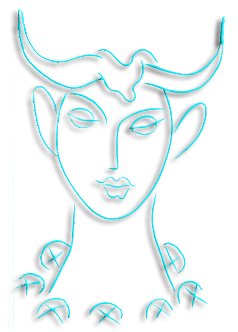 In the Age of Taurus the bull was worshipped as divine. After
perhaps as many as 25,000 preceding years of bull worship, it is not surprising that the bull figured significantly in the Minoan civilization. A bull's
foot appears twice on the Phaistos Disk (left). Egypt had its Serapis, the sacred Osiris-Apis bull. Baal was widely worshipped,
later on the Israelites had their golden calf Moshe (Moses), and painted on the walls of buildings in ancient Sumer are humans with horns. The horns tell
of their status as gods and goddesses. (Minoan Queen Pasiphae drawn by Picasso, right)
In the Age of Taurus the bull was worshipped as divine. After
perhaps as many as 25,000 preceding years of bull worship, it is not surprising that the bull figured significantly in the Minoan civilization. A bull's
foot appears twice on the Phaistos Disk (left). Egypt had its Serapis, the sacred Osiris-Apis bull. Baal was widely worshipped,
later on the Israelites had their golden calf Moshe (Moses), and painted on the walls of buildings in ancient Sumer are humans with horns. The horns tell
of their status as gods and goddesses. (Minoan Queen Pasiphae drawn by Picasso, right)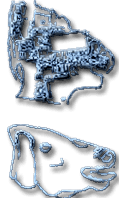 The idea of the bull-god
is foreign to many of us, although it should not be. Even today in India the bull is sacred, and in Spain and Mexico bull sports are still popular, as are
rodeos in the U.S. In Crete, the bull apparently was at the center of both religion and sport. This history of bull-worship clears up some of the mystery
of the Minoan legend of the Minotaur, a bull-being at the center of the bull sports and the maze. It clears up some mystery about Zeus, the Greek
god who often appeared as a bull. And it also shines some light on the worship of the bull-born Dionysis. (Left, Bronze Age palace
groundplan at Mallia, Crete compared with bull's head)
The idea of the bull-god
is foreign to many of us, although it should not be. Even today in India the bull is sacred, and in Spain and Mexico bull sports are still popular, as are
rodeos in the U.S. In Crete, the bull apparently was at the center of both religion and sport. This history of bull-worship clears up some of the mystery
of the Minoan legend of the Minotaur, a bull-being at the center of the bull sports and the maze. It clears up some mystery about Zeus, the Greek
god who often appeared as a bull. And it also shines some light on the worship of the bull-born Dionysis. (Left, Bronze Age palace
groundplan at Mallia, Crete compared with bull's head)
![]()
![]() In the Age of Aries the bull-god
gives over to the ram, whose Golden Fleece is the object of the quest of Jason and the Argonauts. They stopped worshipping the bull - in fact, they slayed
the bull in Crete, or Theseus did, in the legend of Theseus and the Minotaur. Following the Age of Aries is the Piscean Age in which a divine fish
symbolizes the Son of God as the "fisher of men." As we move into the Age of Aquarius, the cup is the symbol of the divine and holds the Water of Life, and
the Knights of the Round Table quest for the Holy Grail. One way or another, either directly or indirectly, we are influenced by the stars. Are they
really eternal powers? The Minoans apparently believed so.
In the Age of Aries the bull-god
gives over to the ram, whose Golden Fleece is the object of the quest of Jason and the Argonauts. They stopped worshipping the bull - in fact, they slayed
the bull in Crete, or Theseus did, in the legend of Theseus and the Minotaur. Following the Age of Aries is the Piscean Age in which a divine fish
symbolizes the Son of God as the "fisher of men." As we move into the Age of Aquarius, the cup is the symbol of the divine and holds the Water of Life, and
the Knights of the Round Table quest for the Holy Grail. One way or another, either directly or indirectly, we are influenced by the stars. Are they
really eternal powers? The Minoans apparently believed so.

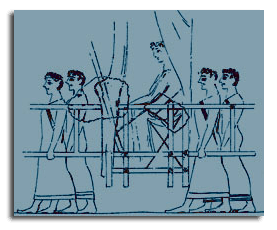 With this new power of thought and technological capability comes the wealth, ease and abundance that we associate with the Minoan civilization, a phenomenal flower
that blossomed in the middle of the Aegean Sea. The Greek creation myth tells the story of how it came to pass that the people were so blessed.
It was because the goddess gave them a son--Zeus--who in turn overthrew the old gods. It is not yet the Age of Pisces when the gift is the son of god.
It is the Age of Aries when the gift is the son of goddess. (left, palenquin pictograph on the Phaistos Disk, right, Minoan palenquin)
With this new power of thought and technological capability comes the wealth, ease and abundance that we associate with the Minoan civilization, a phenomenal flower
that blossomed in the middle of the Aegean Sea. The Greek creation myth tells the story of how it came to pass that the people were so blessed.
It was because the goddess gave them a son--Zeus--who in turn overthrew the old gods. It is not yet the Age of Pisces when the gift is the son of god.
It is the Age of Aries when the gift is the son of goddess. (left, palenquin pictograph on the Phaistos Disk, right, Minoan palenquin)![]()
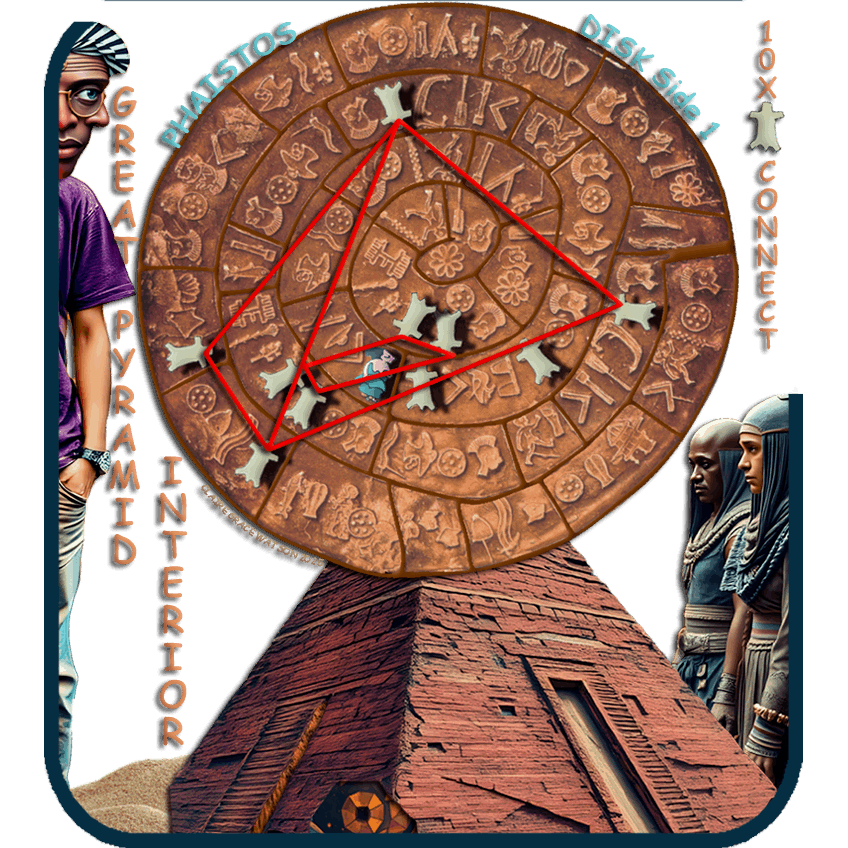
![]()
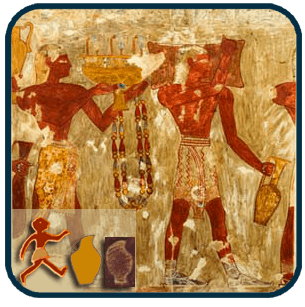
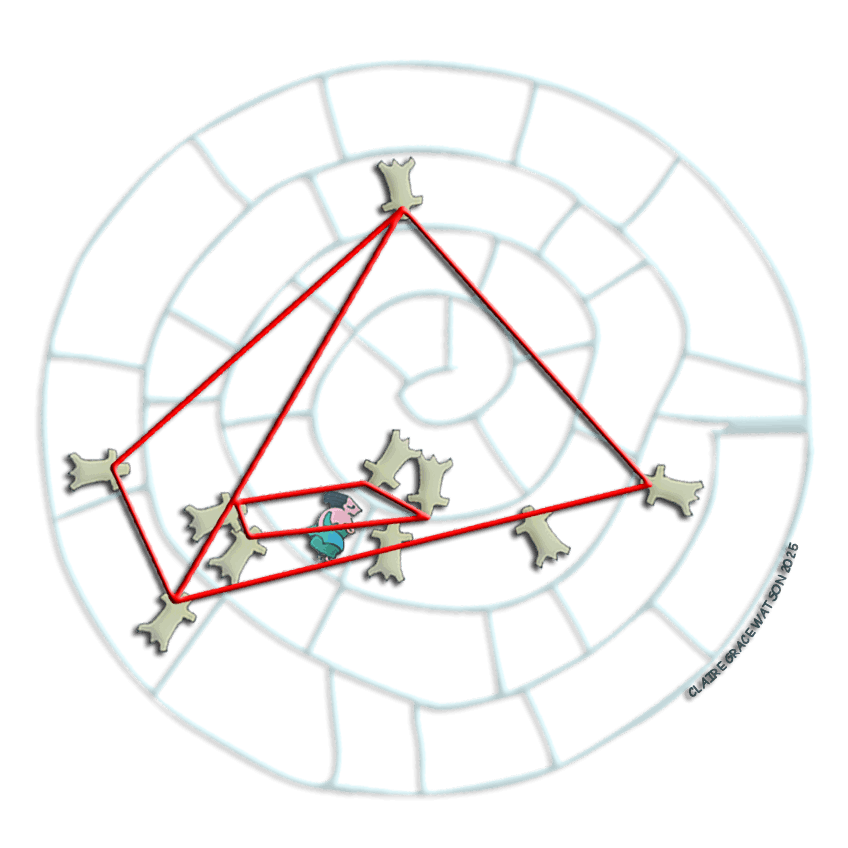 The Goddess beneath the Pyramid - Isis/Rhea
The Goddess beneath the Pyramid - Isis/Rhea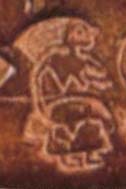 Connecting the 10 identical Golden Fleece signs on Side 1 reveals a second pyramid pictograph that appears to be the interior of the Great Pyramid. At the bottom of this pyramid we see, not the violence of Theseus battling the Minotaur as in the Maze of Daedalus, but a depiction of love and caring, a woman nursing a baby, illumined by the door leading to the lower level. This might be a depiction of the Egyptian goddess Isis or it may be the Minoan version of this goddess, Rhea.
Connecting the 10 identical Golden Fleece signs on Side 1 reveals a second pyramid pictograph that appears to be the interior of the Great Pyramid. At the bottom of this pyramid we see, not the violence of Theseus battling the Minotaur as in the Maze of Daedalus, but a depiction of love and caring, a woman nursing a baby, illumined by the door leading to the lower level. This might be a depiction of the Egyptian goddess Isis or it may be the Minoan version of this goddess, Rhea.
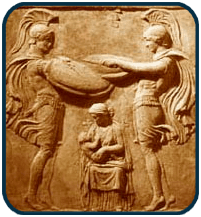 The Phaistos Disk image of Rhea (above left), and the one to the left, bears the influence of the Isis-Osiris mythology in which Isis, after the death of Osiris, feeds the baby Dictys with her finger while with the other hand she beats her
breast in mourning. In Greek/Minoan mythology Great goddess Rhea surrounded her baby Zeus with Warriors beating their shields to drown the cries of the baby so his father Kronos (Time) wouldn't hear him and eat him, as he had all their other children.
The Phaistos Disk image of Rhea (above left), and the one to the left, bears the influence of the Isis-Osiris mythology in which Isis, after the death of Osiris, feeds the baby Dictys with her finger while with the other hand she beats her
breast in mourning. In Greek/Minoan mythology Great goddess Rhea surrounded her baby Zeus with Warriors beating their shields to drown the cries of the baby so his father Kronos (Time) wouldn't hear him and eat him, as he had all their other children.



![]()
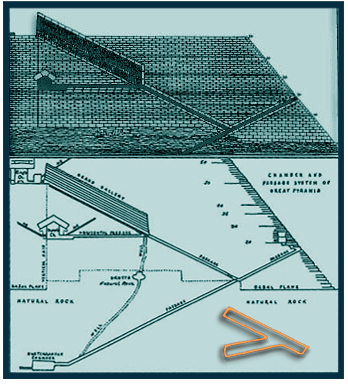 Great Pyramid Interior
Great Pyramid Interior  Is this the pictograph for Pi? The pictograph may be the primitive symbol for Pi, 3.1416, to describe the properties of a circle. The short line of the symbol is the radius (r) of a circle and the long line is the diameter (d). The ratio of the circumference of a circle (c) to its diameter (d=2r) is a constant number called Pi, which equals c divided by 2r+3.1416.
More about Egypt from someone who toured it during that ancient time: An Account of Egypt by Herodotus
Is this the pictograph for Pi? The pictograph may be the primitive symbol for Pi, 3.1416, to describe the properties of a circle. The short line of the symbol is the radius (r) of a circle and the long line is the diameter (d). The ratio of the circumference of a circle (c) to its diameter (d=2r) is a constant number called Pi, which equals c divided by 2r+3.1416.
More about Egypt from someone who toured it during that ancient time: An Account of Egypt by Herodotus
![]()
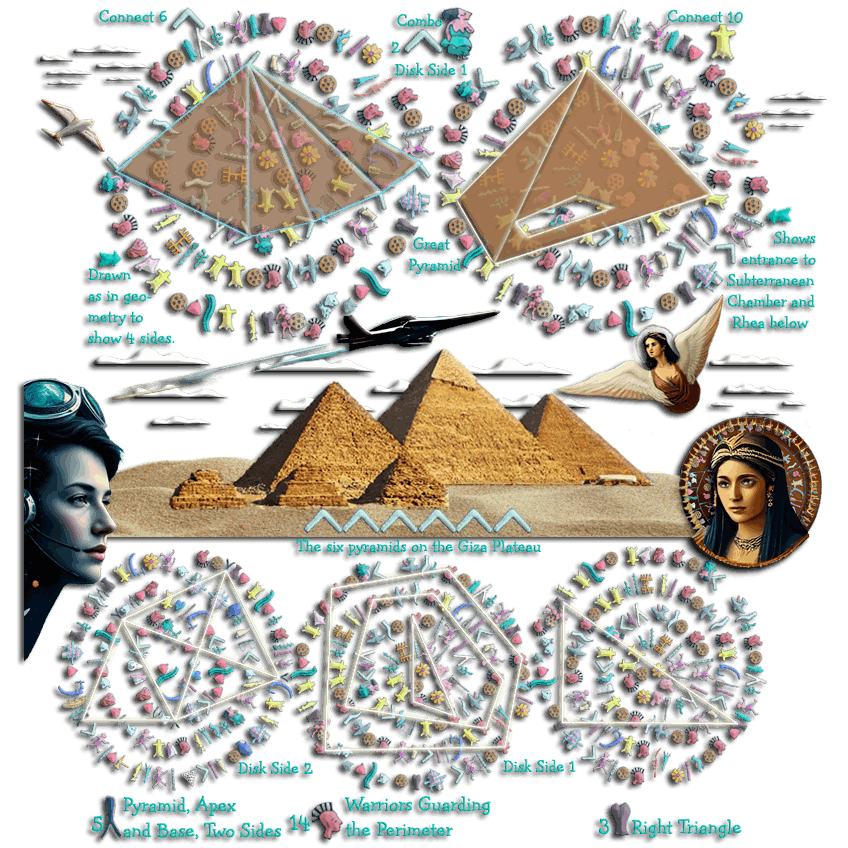 Warriors Guarding the Perimeter
Warriors Guarding the Perimeter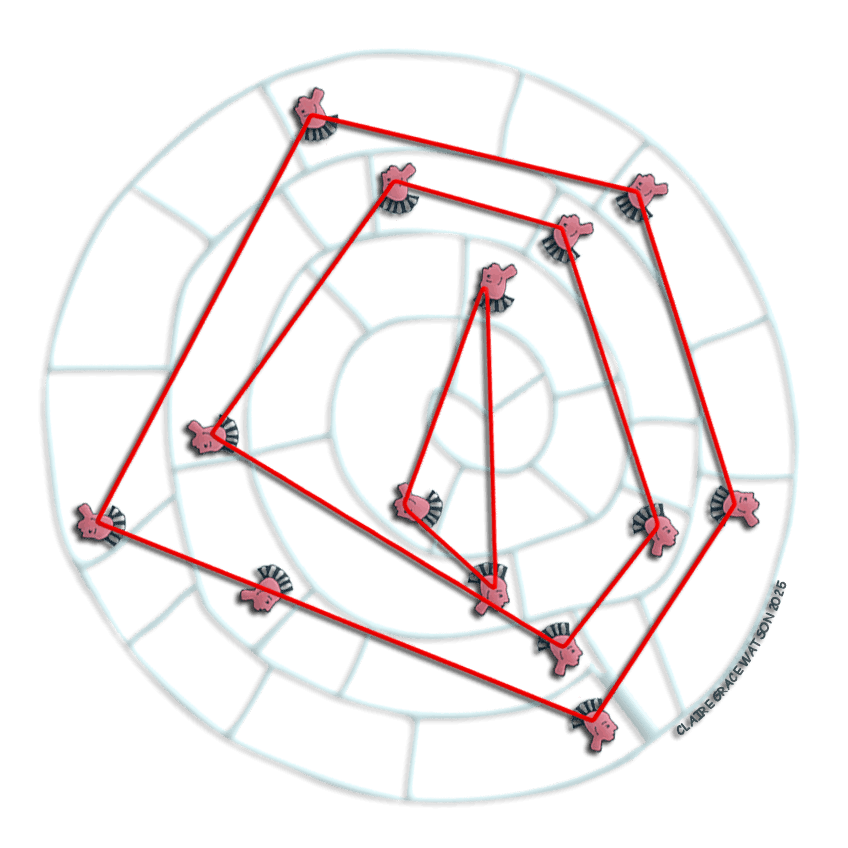
 14 Phaistos Disk Warrior images may point to Minoan mercenaries along the Nile. Perhaps Minoans paid handsomely for access to the Great Pyramid, and traveled with warriors for protection. (And fourteen is about how many I would want to take with me today :)
14 Phaistos Disk Warrior images may point to Minoan mercenaries along the Nile. Perhaps Minoans paid handsomely for access to the Great Pyramid, and traveled with warriors for protection. (And fourteen is about how many I would want to take with me today :)
![]()
![]()
![]()
![]()
![]()
![]()
![]()
![]()
![]()
![]()
![]()
![]()
![]()
![]()
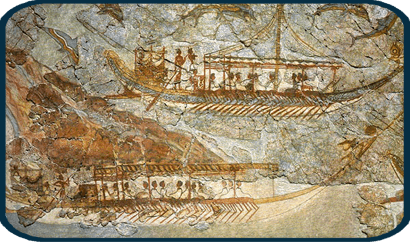 Minoan ferries at Santorini, 1600 BCE
Minoan ferries at Santorini, 1600 BCE


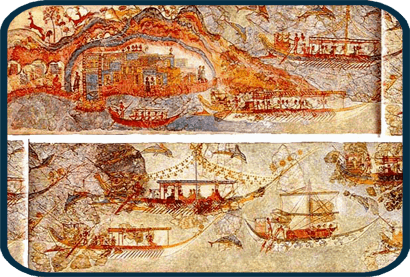 Minoan Ferries at Santorini
Minoan Ferries at Santorini![]()
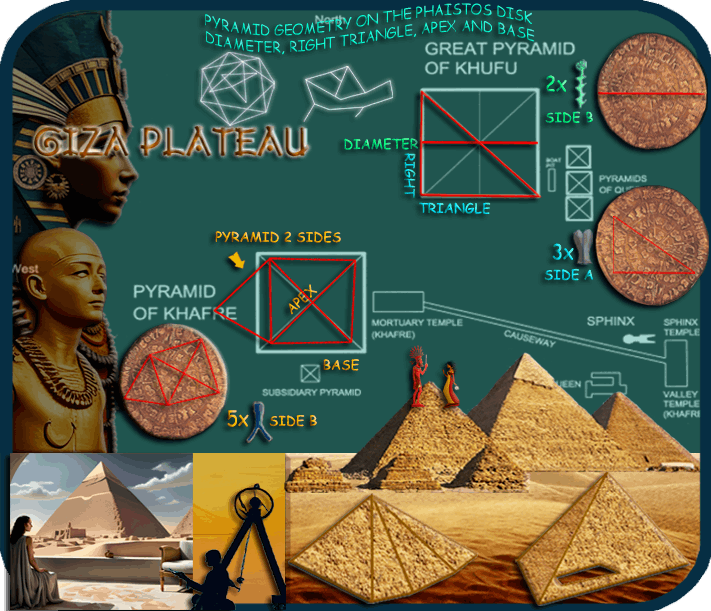 Phaistos Disk large, hidden pictograph
Phaistos Disk large, hidden pictograph
and satellite image of the Great Pyramid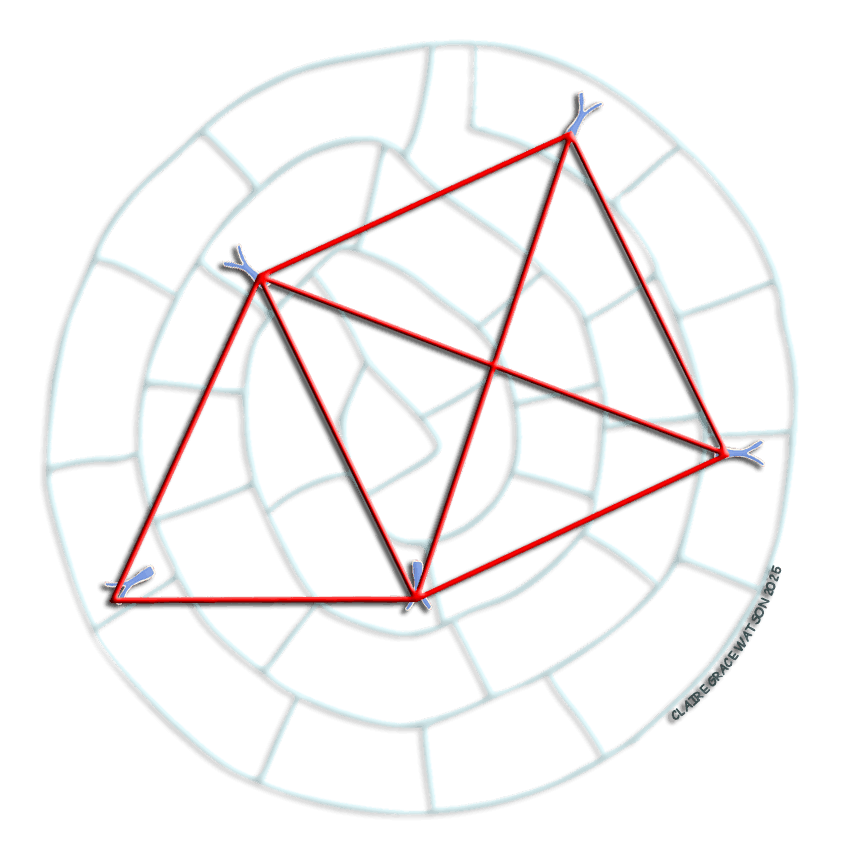
![]()
![]() and magnifying lens glasses
and magnifying lens glasses ![]()
![]() climb to the top of the pyramid
climb to the top of the pyramid ![]() to view the constellations?
to view the constellations?
![]()
![]()
![]() In order to view and be able to portray a perfect image of the constellation Argo on the Phaistos Disk, the disk creator, perhaps Daedalus, could have made
telescopes, and even binoculars (left), using rock crystals with optical quality for lenses. It seems logical that many of these
pictographs on the Phaistos Disk represent the stars and constellations viewed through those lenses. The Archaeological Museum in Herakleion, Crete has
many such lenses on display, several of them found in a sacred cave on Mt. Ida in Crete (3rd left), also said to be a meeting place for mysterious ceremonies, perhaps indicated by the Hoodwink that doubles for the cave entrance. In this cave, King Minos received his instructions directly from Zeus, according to mythology. Perhaps there was a secret cave
cult having to do with astronomy.
In order to view and be able to portray a perfect image of the constellation Argo on the Phaistos Disk, the disk creator, perhaps Daedalus, could have made
telescopes, and even binoculars (left), using rock crystals with optical quality for lenses. It seems logical that many of these
pictographs on the Phaistos Disk represent the stars and constellations viewed through those lenses. The Archaeological Museum in Herakleion, Crete has
many such lenses on display, several of them found in a sacred cave on Mt. Ida in Crete (3rd left), also said to be a meeting place for mysterious ceremonies, perhaps indicated by the Hoodwink that doubles for the cave entrance. In this cave, King Minos received his instructions directly from Zeus, according to mythology. Perhaps there was a secret cave
cult having to do with astronomy.

![]()
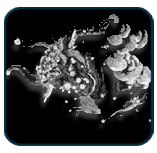 The pictographs on the disk may be the "so below"
counterpart to the "as above" constellations. The disk is only about 6.25" diameter, a little bigger than a CD, yet contains 240 pictographs (121 one side,
119 the other). To put 48 constellations on something this small would require that some of
the pictographs that represent them be "abbreviated," which would make these pictographs, already difficult to define, even more challenging.
For example, the entire constellation Taurus might be represented by the bull's foot on the disk (left) or all of
Capricorn could be represented by the horn (left).
The pictographs on the disk may be the "so below"
counterpart to the "as above" constellations. The disk is only about 6.25" diameter, a little bigger than a CD, yet contains 240 pictographs (121 one side,
119 the other). To put 48 constellations on something this small would require that some of
the pictographs that represent them be "abbreviated," which would make these pictographs, already difficult to define, even more challenging.
For example, the entire constellation Taurus might be represented by the bull's foot on the disk (left) or all of
Capricorn could be represented by the horn (left).
![]() identical Boat signs on side 2 are connected with lines.)
identical Boat signs on side 2 are connected with lines.) 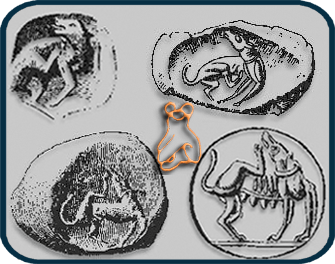

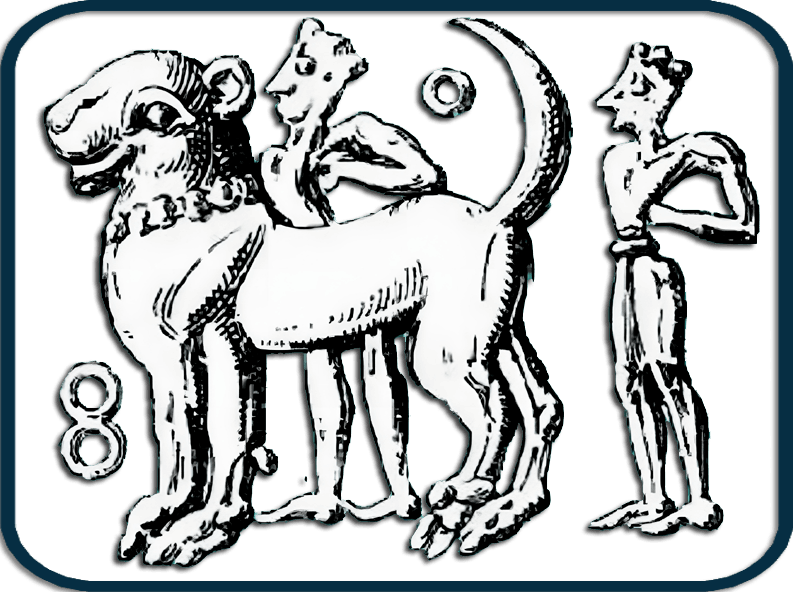 Minoan Cylinder Seal
Minoan Cylinder Seal
![]()
![]()
![]() The circle above the great dog could read "star" and the figure 8 symbol to the left, two stars combined, could read "star group" or constellation, in this case Great Dog, Canis Major, with the largest star in the sky, Sirius.
The figure 8 might therefore be a pictograph for constellation, logically so because the stars are infinite, and we might also use it as a clue to the solution of the Phaistos Disk maze puzzle.
The circle above the great dog could read "star" and the figure 8 symbol to the left, two stars combined, could read "star group" or constellation, in this case Great Dog, Canis Major, with the largest star in the sky, Sirius.
The figure 8 might therefore be a pictograph for constellation, logically so because the stars are infinite, and we might also use it as a clue to the solution of the Phaistos Disk maze puzzle. 
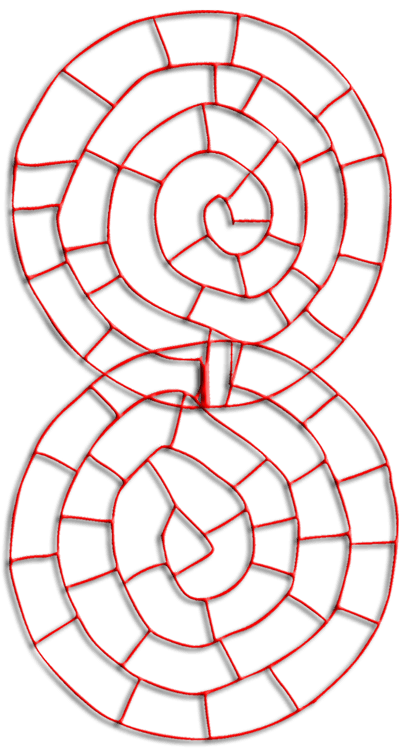 If it is a sign for constellation, this would make the maze puzzle solution even more a-mazing! The solution would be their symbol for constellation and a validation that many of the geometries contained by the Phaistos Disk are indeed constellations. It would mean the two sides of the Phaistos Disk, individually, represent "star," and connected together they represent "star group" or constellation. So, the Phaistos Disk would have been an attempt to preserve all the constellations the Minoans had identified, a subject and effort worthy of a pottery art masterpiece, I think :) (Phaistos Disk left, pictographs removed)
If it is a sign for constellation, this would make the maze puzzle solution even more a-mazing! The solution would be their symbol for constellation and a validation that many of the geometries contained by the Phaistos Disk are indeed constellations. It would mean the two sides of the Phaistos Disk, individually, represent "star," and connected together they represent "star group" or constellation. So, the Phaistos Disk would have been an attempt to preserve all the constellations the Minoans had identified, a subject and effort worthy of a pottery art masterpiece, I think :) (Phaistos Disk left, pictographs removed)

![]()
The number One
The Point within the Circle
"I speak not fictitious things, but that which is certain and true."The number Two - Diameter
The Cross within the Circle
"What is below is like that which is above, and that which is above is like that
which is below, to accomplish the miracles of one thing." The number Three - Triangle
The Hearth of the Universe
"And as all things are produced by the one word of one Being, so all
things were produced from this one thing by adaptation."The number Four
The Square
within the Circle
"Its father is the Sun, its mother the Moon; the wind carries it in its belly,
its nurse is the earth."The number Five
Pentagon, pentagram
"It is the father of perfection
throughout the world." The number Six
Hexagon, hexagram
"The power is vigorous if it be
changed into earth." The number Seven
Heptagon, heptagram
"Separate the earth from the fire, the subtle from the gross, acting prudently and
with judgment."The number Eight
Octagon, octagrams
"Ascend with the greatest sagacity from the earth to heaven, and then again
descend to the earth, and unite together the powers of things superior and things inferior. Thus you will obtain the glory of the whole world, and
obscurity will fly far away from you."The number Nine
Enneagon, enneagrams
"This has more fortitude than
fortitude itself, because it conquers every subtle thing and can penetrate every solid."The number Ten
Dekagon, dekagrams
"Thus was the world formed."The number Eleven
Endekagon, endekagrams
"Hence proceed wonders, which are here established."The number Twelve
Dodekagon, the dodekagrams
"Therefore, I am called
Hermes Trismegistus, having three parts of the philosophy of the whole world."Precept 13. "That which I had to say concerning the operation of the sun is completed."
![]()

![]()
![]() The properties of a circle are described efficiently by pi, 3.1416.
The symbol for pi on the Phaistos Disk might be the "Y" sign, repeated 3 times on Side 1. The short line of the symbol is the radius (r) of a
circle and the long line is the diameter (d). The ratio of the circumference of a circle (c) to its diameter (d=2r) is a constant number called pi,
which equals c divided by 2r+3.1416. 2r with a vertex is a triangle = 3. A lingering association with the number 14 of 3.1416 could come from
Egyptian mythology, in which the god Typhon, out pig hunting (2nd left) with his dogs (3rd left),
chopped his brother Osiris into 14 pieces with an axe (4th right).
The properties of a circle are described efficiently by pi, 3.1416.
The symbol for pi on the Phaistos Disk might be the "Y" sign, repeated 3 times on Side 1. The short line of the symbol is the radius (r) of a
circle and the long line is the diameter (d). The ratio of the circumference of a circle (c) to its diameter (d=2r) is a constant number called pi,
which equals c divided by 2r+3.1416. 2r with a vertex is a triangle = 3. A lingering association with the number 14 of 3.1416 could come from
Egyptian mythology, in which the god Typhon, out pig hunting (2nd left) with his dogs (3rd left),
chopped his brother Osiris into 14 pieces with an axe (4th right).
![]()
![]() The Egyptian goddess Isis found all the pieces of Osiris that
Typhon had scattered, except for his "generative member." Unfortunately, it was eaten by the Nile crab and the "sharp-snout" fish.
As a result, the crab and the sharp-snout were venerated by the Egyptian priests and declared taboo to eat, along with the pig that ate some
other pieces of Osiris. The crab appears once on Side 1, the sharp-snout appears four times in Side 2 and twice on Side 1, and the pig once on side 1.
The Egyptian goddess Isis found all the pieces of Osiris that
Typhon had scattered, except for his "generative member." Unfortunately, it was eaten by the Nile crab and the "sharp-snout" fish.
As a result, the crab and the sharp-snout were venerated by the Egyptian priests and declared taboo to eat, along with the pig that ate some
other pieces of Osiris. The crab appears once on Side 1, the sharp-snout appears four times in Side 2 and twice on Side 1, and the pig once on side 1.
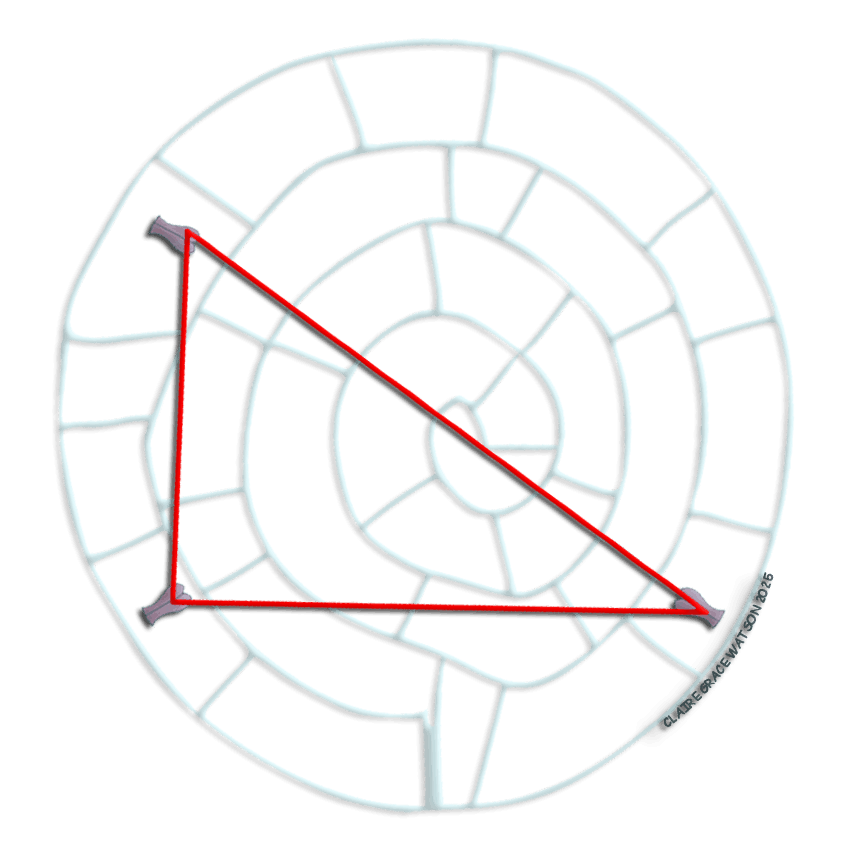
![]() In this geometry theology,
the triangle is "sacred" because it represents the "plain of truth," the "hearth of the universe" and thesis-antithesis-synthesis. In mysticism of a
much later time, gnosis (knowledge of holy things) is beyond reach unless one's feet have crossed the "plain of truth," meaning the study of Sacred
Geometry and the triangle, particularly the magic 3-4-5 triangle, the perfect right triangle (left), revealed by connecting
the 3 Daedalus Wings of Icarus pictographs on side 1 of the Phaistos Disk (2nd left).
In this geometry theology,
the triangle is "sacred" because it represents the "plain of truth," the "hearth of the universe" and thesis-antithesis-synthesis. In mysticism of a
much later time, gnosis (knowledge of holy things) is beyond reach unless one's feet have crossed the "plain of truth," meaning the study of Sacred
Geometry and the triangle, particularly the magic 3-4-5 triangle, the perfect right triangle (left), revealed by connecting
the 3 Daedalus Wings of Icarus pictographs on side 1 of the Phaistos Disk (2nd left).![]()
![]()
 Copyright Notice - Disk of the World - Text and images copyrighted March 21, 1993-2025, Claire Grace Watson, B.A., M.S.T., U.S. Copyright and under the Digital Millennium Copyright Act of 1998, All rights reserved. No part of this web page may be reproduced or transmitted in any form or by any means without written permission from the author, except for the inclusion of brief quotations in a review.
Copyright Notice - Disk of the World - Text and images copyrighted March 21, 1993-2025, Claire Grace Watson, B.A., M.S.T., U.S. Copyright and under the Digital Millennium Copyright Act of 1998, All rights reserved. No part of this web page may be reproduced or transmitted in any form or by any means without written permission from the author, except for the inclusion of brief quotations in a review.